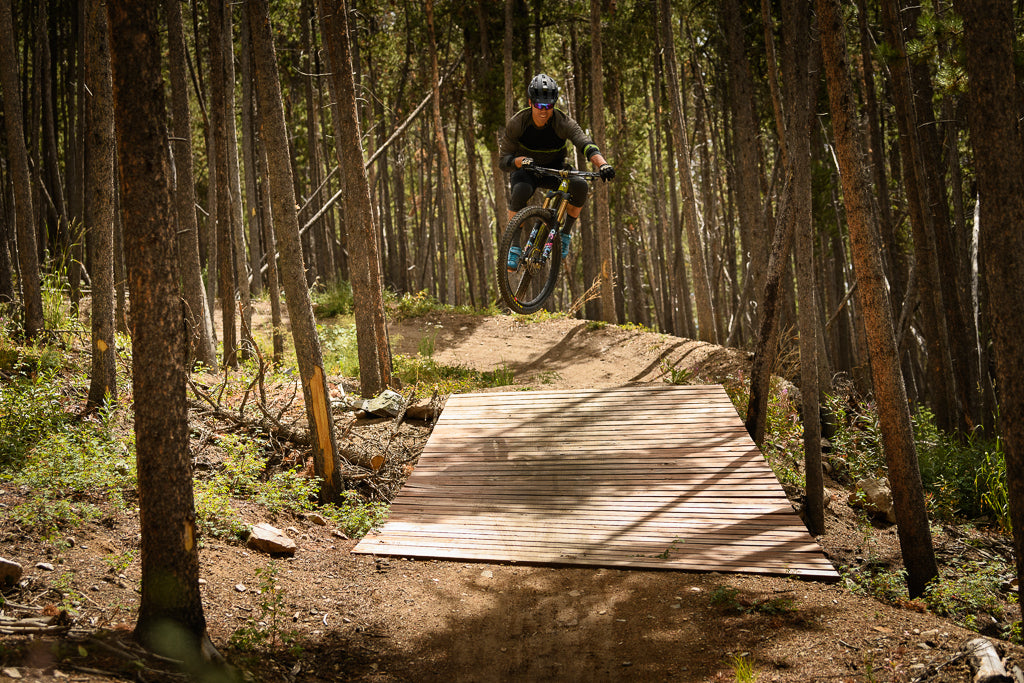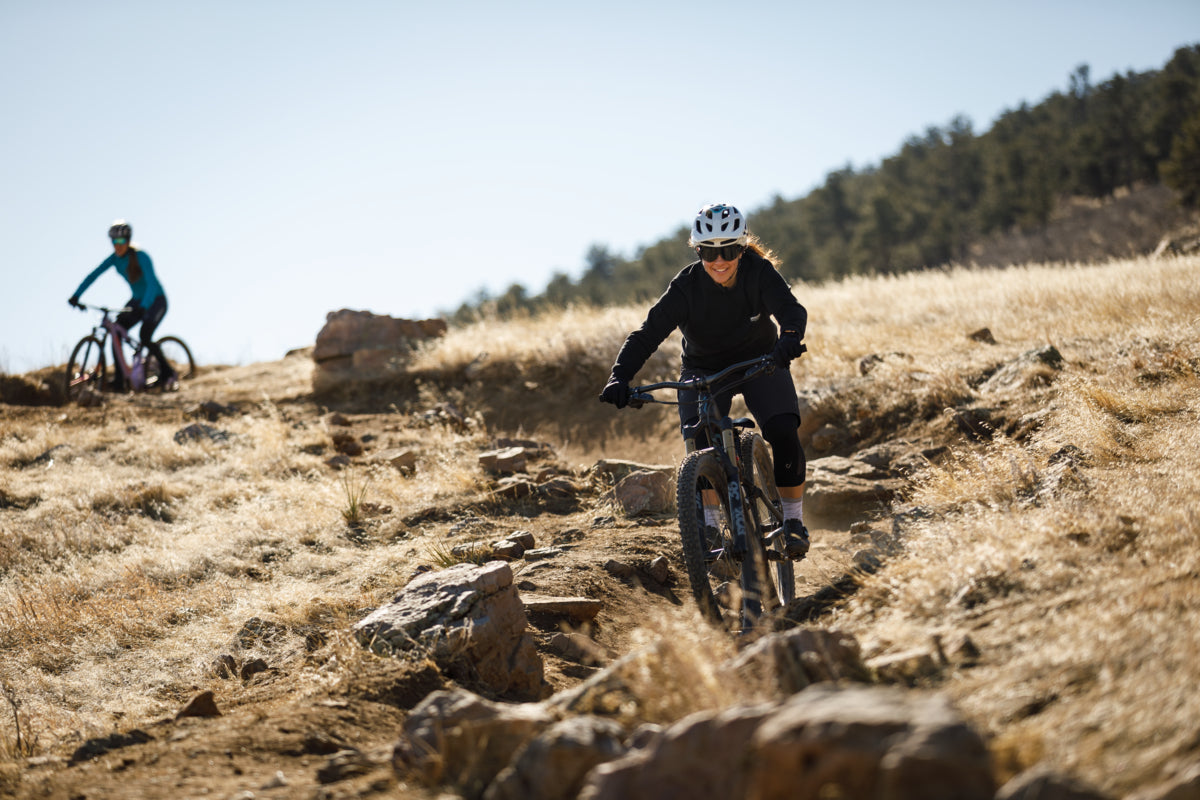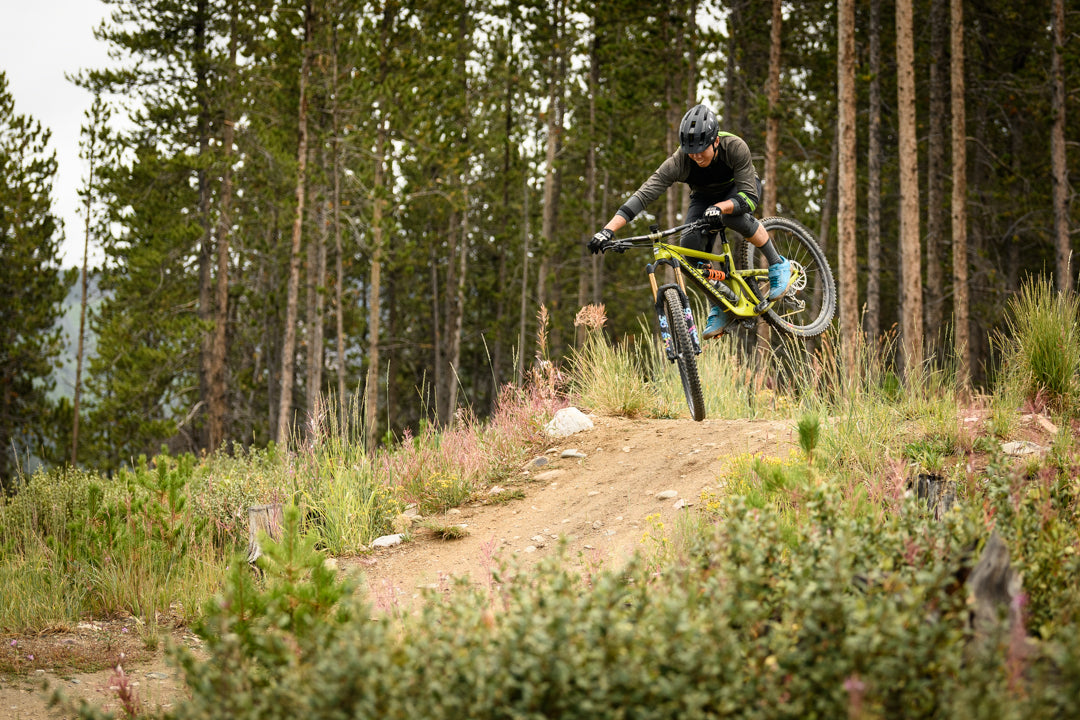You’re going to a big, important party, but you’re iffy about the dress code. Would you rather show up overdressed or underdressed?
A lot of mountain bikers face a similar dilemma, but instead of choosing the right clothes, it’s about choosing the right bike. You've probably heard certain bikes described as “too much bike” or “not enough bike.” But what does that mean?
In mountain biking, suspension travel often receives the most attention when riders are looking at bike specs. Depending on your skill, riding style, and terrain, there is likely an ideal amount of suspension travel. Other specs such as geometry, wheels, and tires matter too, but they are usually tailored to match a bike's suspension.
Most modern mountain bikes will have somewhere between 100mm and 170mm of suspension travel. This covers everything from cross-country race machines to versatile mid-travel trail bikes to hard-hitting enduro bikes. (If you want to learn more about how mountain bikes are categorized check out our Mountain Bike Buyer’s Guide.)
So what's the right amount of travel for you?
[button]SHOP MOUNTAIN BIKES[/button]
MTB travel: The basics
In case you're new to riding, mountain bike suspension travel is a measurement of how much a wheel can move to absorb bumps. On the front, mountain bike travel comes from your suspension fork. At the rear, MTB travel is provided by some configuration of frame pivots that compress a rear shock.
When to choose a long-travel MTB
 Going big is easier on my 150mm enduro bike.
Going big is easier on my 150mm enduro bike.
Long-travel bikes usually have 150-170mm of rear travel to handle tough downhill trails. Front travel often matches rear travel but sometimes can be more.
Trail and enduro bikes fall into this category. They absorb big hits and smooth out rough terrain. If you regularly ride steep or gnarly trails, a bike like this makes a lot of sense.
If you're mostly riding mellow flow trails though, a big and burly long-travel bike might be overkill. You won't be able to use all the suspension travel you paid for. The bike may feel cumbersome, maybe a bit boring, and you’ll have to expend more energy to push it around and climb uphill.
But let’s say you lack confidence on descents. A more capable enduro bike with ample suspension travel could help you enjoy riding more by increasing your confidence, comfort, and giving you more margin for error.
Some ride big and burly bikes everywhere because they're fit enough to pedal a long-travel bike up big climbs and on long rides without much trouble. For them, being overbiked isn't a handicap, and it's worth it for when the trail gets gnarly. If you care more about descending as fast as possible more than having a bike that's efficient for pedaling or climbing, long-travel bikes will cater more to your style.
[button]SHOP LONG-TRAVEL MOUNTAIN BIKES[/button]
When to choose a short-travel MTB
 Sprinting up climbs is easier on my 100mm XC bike.
Sprinting up climbs is easier on my 100mm XC bike.
Short-travel bikes usually have 100-120mm of travel to maximize efficiency. In some cases, these bikes could have forks with 10-20mm more travel to make them more versatile on descents.
XC and short-travel trail bikes fall into this category. They are efficient and usually feel more agile than longer-travel bikes. If you race cross-country, do long adventure rides, or stick to mellow trails, these are the best option.
If you venture onto steep and gnarly downhill tracks with big rocks and jumps, a short-travel bike will start to feel sketchy. There’s a good chance you’ll have to ride slower and more cautiously than you would on a long-travel bike, taking easier lines and occasionally skipping tough sections.
But let’s say you dread going uphill and are constantly getting dropped by fitter riders. A bike with less travel that’s lighter and more efficient could help you go faster and expend less energy.
If you’re a skilled rider that just wants to make riding more exciting, short-travel bikes provide a lot more trail feedback and give you less room for error. You have to stay focused, be more selective about lines, and be more active with your body. For some, this can be a more enjoyable ride experience than just sitting back and letting a long-travel bike do the hard work for you.
[button]SHOP SHORT-TRAVEL MOUNTAIN BIKES[/button]
So how much suspension travel do I need?
 There may not be a perfect bike for every trail. Most of the time, you'll either be overbiked (too much travel) or underbiked (too little travel). I asked a couple of our shop's most experienced riders what they thought about being chronically overbiked or underbiked and here’s what they have to say:
There may not be a perfect bike for every trail. Most of the time, you'll either be overbiked (too much travel) or underbiked (too little travel). I asked a couple of our shop's most experienced riders what they thought about being chronically overbiked or underbiked and here’s what they have to say:
Seth H., Merchandising Manager
"I started on an XC hardtail and rode everything, even gnarly downhills on it. It had a dropper and I did just fine. I really thought it was all I would ever need. Then I went to Moab. I rode a borrowed enduro bike on The Whole Enchilada and it kind of opened my eyes. I bought a bigger bike not long after and started riding all my regular trails again. It changed how I rode.
"Personally, I really don’t mind being overbiked for most of my riding now. I ride alone a lot so I go my own pace. But I'm also decently fit and I can keep up with everyone I ride with on my bigger bike (an Ibis Ripmo). If you’re fit, I say go as big as you want."
Chad H., Warehouse Manager
"I would prefer to be underbiked on the majority of trails. Being underbiked keeps the skills sharp and makes the trail an exciting challenge. I feel that being overbiked takes the challenge and excitement out of trails. It leads to laziness and dulls your skill as a rider.
"Right now for me, I believe the best bike for 85 percent of the riding I do will be a full suspension cross country bike, like the Santa Cruz Blur. I would add a dropper seatpost and Fox Step-Cast 34 120mm fork just to give it a tiny bit more capability. Or the new Trek Top Fuel, or possibly a Yeti SB100 are good options. It's what people are calling 'downcountry' now, even though I hate the term. It will be a little bit more capable than a full cross country bike, but it’ll have the same quick handling and speed. That'll be perfect for me."
What about mid-travel "quiver-killer" mountain bikes?
I always keep at least two mountain bikes in my quiver: a long-travel enduro bike and a short-travel XC bike. This lets me tackle everything from downhill bike parks to short-track XC races. But for many riders, a mid-travel trail bike is all you need.
Mid-travel bikes are a good compromise between downhill performance and pedaling/climbing efficiency. They usually have 120-140mm of travel. Many call these bikes "quiver-killers," because they can do it all (well, almost). I even spent a full season on a quiver-killer, just to see how well it worked for a wide range of riding and was pleasantly surprised by how versatile it actually was.
However, these bikes don't completely excel at anything. A longer-travel bike will be better downhill and a shorter travel bike will be more efficient for racing. Ultimately, if you can only have one bike for casual riding, or you're unsure what type of mountain bike you need for your local trails, this category is the best option.
[button]SHOP MID-TRAVEL MOUNTAIN BIKES[/button]
How to choose a mountain bike
 I usually ride longer-travel bikes, even on XC trails. I'm the type that's willing to sacrifice weight and climbing efficiency to be able to go all out on every downhill.
I usually ride longer-travel bikes, even on XC trails. I'm the type that's willing to sacrifice weight and climbing efficiency to be able to go all out on every downhill.
Are your trails rough and rocky or smooth and flowy? Are they fast and steep or tight and technical? Your terrain has a big impact on bike selection. Generally, the rougher, steeper, and faster a trail is, the more travel you'll want and vice versa.
The second step is to know yourself. Your riding ambition is nearly as important as terrain. If you are a ripper who lives for downhills, you'll probably want to support yourself with more travel. But if your ride fantasy involves conquering high mountains, and exploring miles of backcountry trails, you might want to stay light and efficient with less travel.
No matter what, it's possible to have fun riding any bike, and having the ideal amount of suspension travel isn't everything. Keep in mind too that the rider is always going to make a far bigger difference than the bike. Fast descenders drop me on gnarly downhills riding XC hardtails, and fit climbers drop me on uphills riding heavy enduro machines. Good riders take what they have, and make it work.
That being said, you can always play to your strengths or weaknesses. Having a bike that enhances the parts of riding that you care about the most will make mountain biking more fun.
Are you overbiked or underbiked for your trails? Do you prefer long travel or short travel? Or do you have a bike that sits somewhere in the middle? Let us know in the comments!





















